How to Freeze Summer and Use It to Make Things Taste Fresh All Winter
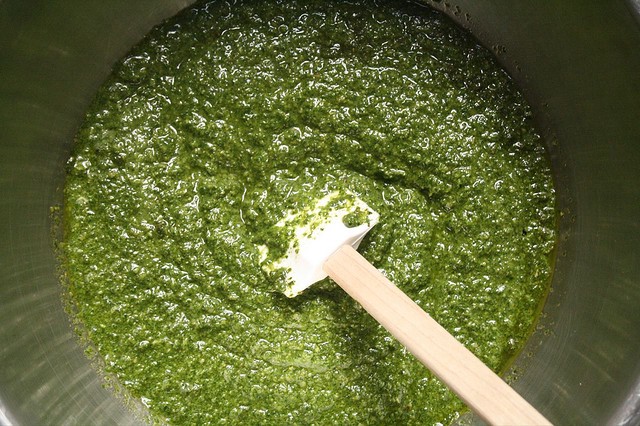
“Pesto is the quiche of the eighties.” Haha, that’s a line from a movie I just saw for the first time. The pesto of this decade is…other kinds of pesto.
Pesto originally comes from Genoa, in northern Italy, where the specific ingredients and preparation were codified sometime in the sixteenth century. That kind of pesto — made with basil leaves, garlic cloves, pine nuts, Parmigiano Reggiano and Pecorino sardo, along with a fair amount of olive oil — is still by far the most popular, though its proper name now, in a world of many types of pesto, would be pesto alla genovese.
Most Italian dishes have, like, four ingredients max, but if one of them is even the tiniest bit different from the way Caesar liked his, it is no longer correct. For example, the Pecorino sardo in pesto alla genovese is not the same as Pecorino Romano, and only a fool would use Romano in place of sardo *shakes fingers as if trying to fling drops of water onto whoever is in front of me*. Anyway, pesto is made in a mortar and pestle, traditionally. (“Pesto” comes from the same root as pestle, as does the word “paste.”) The Italian mortar and pestle, like the French, is typically marble, and the ingredients are crushed in a circular grinding pattern, unlike, say, the “pok pok” smashing method of Thailand.
Now that you’re up to date on the true history of authentic pesto, let’s cheerfully cast that all aside. Pesto, to my modern, non-Italian mind, means nothing more than a paste of herbs and oil, sometimes with other things added, and I always have at least three or four kinds in my freezer; I rarely cook anything without some form of it. Right now, as the summer turns to fall, we are in the dying throes of herb season. Herbs are summer to me, and their aromatic compounds are most potent when they are fresh — not grown in a greenhouse in Argentina, not after a few days of wilting in your fridge. Raw leaves do not normally freeze well (they become soggy and gross when defrosted). But, when mashed into a pesto, they freeze SPECTACULARLY. So now is the time to get out the food processor (or mortar and pestle if you want, but I certainly don’t) and make enormous batches of several kinds of pesto, which you can use to add a hit of summer freshness to food all through the shitty awful nigh-endless winter we’re sure to have, again.
As for the type of plant products to use in a pesto: I like to use almost everything in the “herb” section, which would include parsley, basil, sage, oregano, cilantro, dill, marjoram, and tarragon. There are a few that don’t work in pesto, or don’t work well; mildly tough leaves like thyme and rosemary can be hard to pulse into a paste. Super tough leaves like bay and curry aren’t even really edible, so don’t bother.
My standard technique for freezing and using pesto year-round is about as basic as it gets: wash herbs, chop roughly, toss into food processor (along with other stuff, if desired) and pulse while drizzling oil into the hole in the lid until it reaches the desired texture — thicker than a sauce, but of a single consistency, without chunks. It should pour, but very very slowly.
When you’ve gotten there, pour the pesto into ice cube trays and freeze it. Pop the pesto-cubes out, throw them into a plastic bag, then stuff that back into your freezer. (Once, when I froze all of my pesto into a single, giant block, I had to chip away at it with the tip of my chef’s knife, and it actually broke off. Can you believe that? Anyways, ever since then, I’ve used ice cube trays to avoid this.)
Some herbs, like basil, will turn kind of brownish in the freezer, but this affects neither their flavor nor texture, so don’t worry about it. Beware of freezing with cheese; hard cheeses like Parmesan will do fine, but anything with a higher water content (basically anything that’s not a super hard cheese) will grow shitty giant ice crystals that will fuck up the texture of your pesto. As for defrosting! I mostly think it’s fine to toss small bits of frozen pesto into a hot pan, as long as you’re only in the early stages of cooking (sauteeing onions, for example). But if you’re going to toss the pesto with vegetables as a dressing, or place a spoonful delicately on top of a bowl of soup, you’ll want to properly defrost it. I recommend just leaving a few cubes of pesto in a small bowl or dish while you prepare the whole rest of your dish, and it’ll probably be defrosted by the time you’re ready to use it. If you need it defrosted immediately, microwave very cautiously on half power, otherwise you might damage the delicate herbs.
NOW FOR HOW TO USE YOUR PESTO CUBES.
You can add a pesto at the beginning of your cooking process or at the end, but each way produces different effects. If added at the beginning, along with your onions and garlic and/or chiles and/or ginger or whatever, the pesto will mellow significantly, adding nothing so distinct as a slight herbiness and richness. Added at the end, as a topping, it will be sharper and more intense, especially if you use raw garlic. Both have their uses! And honestly, almost every dish — soups, stir-fries, salads, meat or fish (if you eat such things), roasts, pastas, sandwiches — can benefit from some pesto.
( I am aware that many recipes encourage you to make greens like kale into pesto. I think this is gross; pesto is to add a big hit of flavor, not to like, sneak healthy greens into your diet. I also do not think kale makes for a particularly pleasing pesto; it’s sort of bitter and grainy and funky. Let’s just stick to herbs.)
My go-to pesto for Italian recipes does use basil, but I also like to throw in some parsley to take away some of the licorice-like intensity that basil can have. I always use walnuts in place of pine nuts — the flavor and oil content is similar, and walnuts are priced as if a normal human might buy them. I also leave out garlic; I tend to think the herbs freeze much better than garlic, and I’d rather just add fresh garlic to the dish than mess with the frozen stuff. Otherwise, keep it traditional: herbs, nuts, olive oil, Parmesan. I don’t measure, but roughly, I’d say: one bunch of basil, half a bunch of parsley, a small handful of nuts, and add just enough olive oil until it looks like pesto rather than like chopped herbs. Blend until smooth, freeze. This works well as a flavor base for Italian dishes or sauces, or just tossed with pasta. This makes at least a dozen servings — maybe more if you’re using it as an accent rather than the dish’s flavor focal point.
Parsley pesto is very underrated. Now that I think about it, parsley in general is underrated. I like to blend one bunch of parsley, about half a lemon’s worth of lemon zest, a small handful of walnuts (or macadamia nuts, if I’m feeling fancy) and olive oil, and use it as a base for shellfish dishes. (This will make enough for maybe six servings.) Saute onion and garlic in olive oil until soft, then throw in a cube of this parsley pesto for a few minutes until it thaws and starts to smell, like, really good. Then throw in a dozen clams or mussels or both, pour in about a third of a glass of white wine, drink the other two thirds of a glass of white wine, bring to a boil, cover the pot, lower the heat to let it simmer, and then wait until the wine-y smell is gone and the shellfish have opened. Eat with pasta or bread or both or neither, I’m not the boss of you.
Another good one that is vaguely Indian: cilantro, mint, neutral oil (grapeseed is good), lime juice, and a touch of sugar. It’s sort of like that cilantro-mint chutney you get with takeout Indian food, but more intense, and it works really well with stewed greens. Get a heavy pot, cook some onions and chiles down for awhile in oil, then throw in some curry powder and cook it down some more. Then, throw in a bunch of this pesto until it defrosts, followed by a ton of coarsely chopped greens (spinach, chard, or kale all work great). Add a touch of water to help the steaming/wilting process, stir, cover, and cook until the greens are tender (the amount of time will vary; more for kale, less for spinach). Add in chickpeas at the end. Serve over rice or quinoa.
Or, to make it kind of Mexican, do the same thing but remove the mint from the pesto. Cook the same ingredients the same way, but add garlic at the beginning, and use a mixture of cumin, turmeric, and chile powder (ratio: 2:4:1), instead of curry mix. Also, use black beans instead of chickpeas, and serve with queso fresco (or feta if you can’t find that) and another squeeze of lime. This works great over rice or quinoa. If you’re doing tacos, don’t add the pesto in the beginning — save it until the end, and spoon some over the greens, because tortillas are more strongly flavored than rice and you’ll want a more robust kick of cilantro pesto.
Pretty much any herb can be pesto-ed: just add oil, and maybe nuts or hard cheese, then blend or grind or however you would prefer to reduce them to a pesto-y consistency. I’ve made dill pesto and spooned it over salmon with boiled potatoes, thyme/parsley and lemon pesto for trout, and some mutant kind of chimichurri pesto as a finisher for vegetable soup (to make it chimichurri, add a touch of vinegar). Regardless of which herb and which combination you use, pesto isn’t just for garbage grilled chicken sandwiches at Panera. It’s a way to pretend it’s nice outside even when it’s not.
Crop Chef is a column about the correct ways to prepare and consume plant matter, by Dan Nosowitz, a freelance human who enjoys hot salads and lives in Brooklyn, naturally.
Photo by thebittenword.com
What Does Music Look Like?
What Does Music Look Like?
by Awl Sponsors
This story is brought to you by UE BOOM.

While we each can express ourselves individually through music, what happens if music is expressed socially? With a troupe of dancers, a few buckets of paint and UE BOOM, this video explores how individual, unique styles can collectively contribute to a sensational experience.
Watch this video to see the colorful results and head over to makemusicsocial.com to check out fun ways to #MakeMusicSocial with UE BOOM.
This Week in Lines
by Jake Gallagher
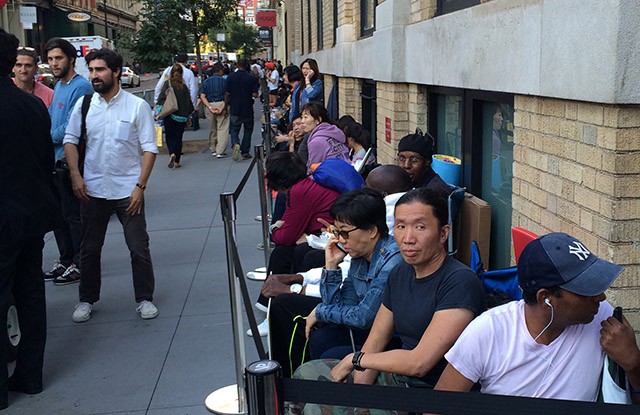
5:26 PM Thursday, September 18th — iPhone 6 launch
Location: Greene and Prince
Length: An entire block
Weather: 75 and sunny
Crowd: Two hundred or so professional line-sitters, with a few fanboys scattered throughout
Mood: Undercharged
Wait time: One. More. Day.
Lingering question: Does the apple fall far from th… oh, fuck it.
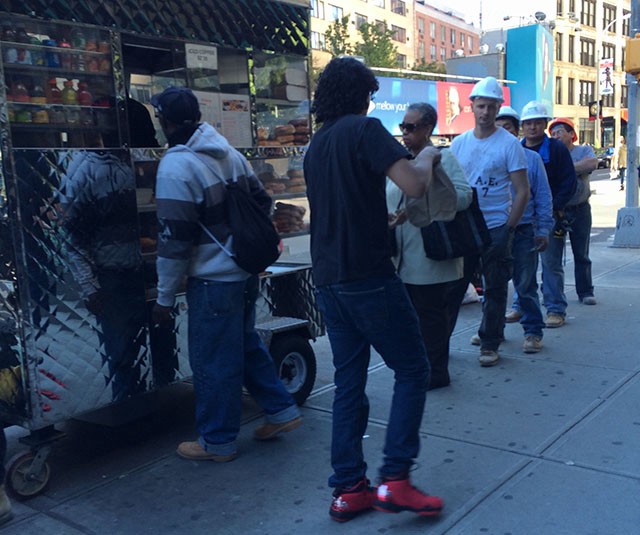
9:02 AM Wednesday, September 17th — corner coffee cart
Location: Lafayette and Bleecker
Length: Six people. Four hard hats.
Weather: 57 and sunny
Crowd: Sluggish office workers alongside workers who built the offices.
Mood: As tepid as the coffee
Wait time: Four minutes
Lingering question: What is the correlation between September morning temperatures and iced coffee consumption?

1:46 PM Wednesday, September 17th — That fake coffee shop from Friends
Location: Broome and Lafayette
Length: Two hundred and thirty-seven people
Weather: 72 and sunny
Crowd: Far more diverse than the show ever was
Mood: Perky, centrally so
Wait time: Roughly five episodes, with commercials
Lingering question: I wonder how Tom’s restaurant is feeling right now?
Jake Gallagher is a writer for A Continuous Lean and other places.
Independence Day
by Hope Whitmore
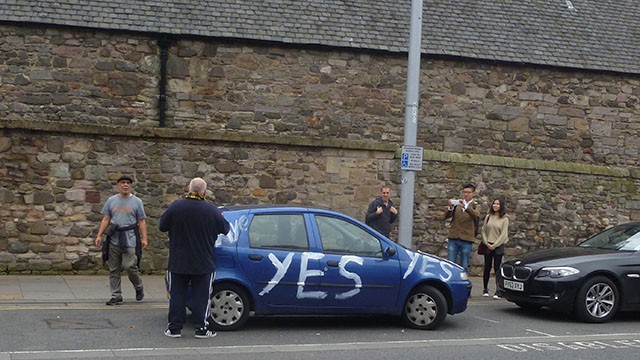
On Wednesday night, the haar descended over Edinburgh, moving east from the sea until it covered the whole city in a filmy fog, blurring the street lights and rendering anything more than a metre ahead nearly invisible. I left my glasses in the pub after my boyfriend’s birthday drinks, and had to run across The Meadows to retrieve them at one in the morning. It was Referendum Eve, the chilliest day yet this September.
The benches where, earlier in the day, YES campaigners had given me a bumper sticker — “But I don’t have a car!” “Take one anyway!” — were now filled with men shouting about communism, trying to drown one another out. Even the trees and bins wore blue YES stickers, the brightness of which cut through the mist.
Earlier that day, I had interviewed Lindsay Jarrett, a woman who scaled the eighty-metre cliffs below Edinburgh Castle to put a foil YES poster in place, despite needing a double lung transplant. Having cloistered myself away for a whole day to work on the interview, she had become huge to me, a symbol of the passion of the YES campaign. I’m English, but apart from brief spells in France and London, I have lived in Scotland for the past ten years.
To cross either box seemed cruel to my friends and people I had interviewed on both sides; I was so torn about what to vote that I almost didn’t.

In August, I was interviewing printers for a story on businesses that might profit from the referendum. “We have done some YES campaign posters,” an assistant eventually told me, contradicting what his boss had told me earlier. “We did the ones for Graham.”
“Oh, we did do those,” the owner said.
“Have you spoken with Graham?” the assistant asked. “He’s interesting, you should go and talk to him, he runs the supermarket on the Royal Mile.”
I went to the wrong shop first, a corner newsagent. I figured the it was the nearest thing to a supermarket the Royal Mile had. I never shopped in that part of town; it was overpriced, tartan-y, not for locals. Then I found it: Just up the street from the Scottish Parliament, a store covered in bright orange posters, demanding in aggressive capital letters:
YOU
YES
YET
A solid man in a pink shirt with grey hair was standing outside, blocking the door like a nightclub bouncer. He looked up and down the street with a proprietary air, watching the passing crowds like a guardian or a jailer.
“Hello,” I said. “I was wondering, is this Graham’s store?”
“Who’s asking?” he replied.
“I was just at the printers,” I said, motioning vaguely in its direction. He looked down at me, and said nothing for about ten seconds while he quietly studied my face. “That’s me,” he finally responded. He pulled a small wooden table and two rickety chairs out from his shop. He explained that he believed Scotland would vote YES, comparing doubters and NO voters to the Vichy French. “After the referendum, they will be shunned,” he said. “No decent people will speak to them.”
As we talked, he called passersby over to him. “You’re a YES?” he asked of everyone until they conceded. Some he knew, others he didn’t. A festival goer walked up the street, a mewling baby strapped to his front. “I know this fella’s name,” Graham said. The man paused. “Dad,” Graham said, beaming, and the guy smiled and walked on.
“The YES Voters are everywhere” Graham said, leaning in close, and lowering his voice. “See that shop across the road? She’s a YES. And down that alleyway, they’re all YESes. Soon the day of reckoning will come, but until then…” He glanced around uncertainly. “…until then, we cannot say.”

In Craigmillar and Niddrie, the poorest boroughs in Edinburgh — and at one time in recent history, some of poorest communities in Western Europe — I met Sean, a young man with red hair, numerous health problems, and a self-declared chip on his shoulder. He’d grown up poor, and like many in Craigmillar and Niddrie, he wanted to escape from the clutches of what he saw as a callous Tory government — to allow Scotland to become its own, more socialist state. He became involved in the campaign after meeting Margo MacDonald, a member of Scottish Parliament and fervent advocate of independence who died last year. For the past year, Sean has volunteered as a canvasser and campaigner seven nights a week. I traipsed around the estates of Niddrie with Sean and his comrades for two nights, knocking on the doors of undecided residents. One woman called down to us from her upstairs window, saying she couldn’t come down, but asking how it was looking. “It’s looking good” Sean said. He slotted some YES Posters through her post box.

I spent much of yesterday outside the Scottish Parliament talking to YES and NO campaigners as the voting was taking place. The building is often described as a modernist monstrosity, but I kind of like it. It’s full of deliberate symbolism: The sprawling complex is in the shape of a tree, and the smaller buildings are leaf-shaped — or as some people say, boat-shaped, showing Scotland’s connection to both the land and the sea; it looks at once as though it is putting down roots, and as though it’s about to sail away. In the center is a horseshoe-shaped chamber of pale wood, in which the members of Parliament decide policy. Above it is the viewing gallery, where the seats are designed to look like speech marks (though once, I heard a child say he thought they looked like big fishes trying to eat “littler” fishes, their mouths open as they swam along).
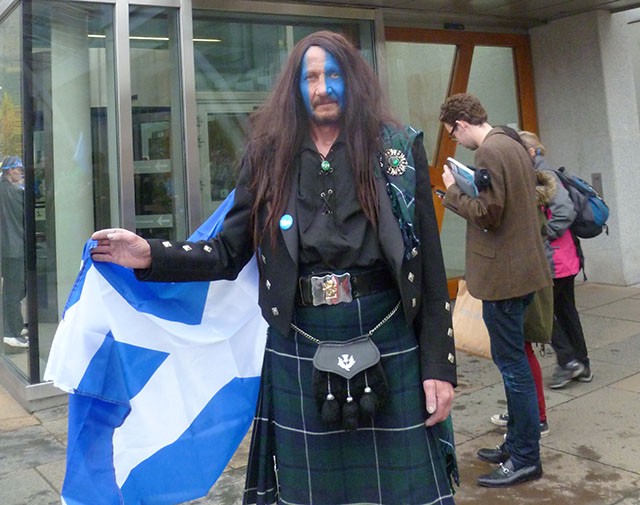
Out front were flags, cameras, banners and balloons. The papers and TV stations were restricted in what they could report, and many journalists stood around, waiting for ten o’ clock, so they could explode onto the internet or airwaves. Most of crowd were fervent YES supporters. There was a man dressed as William Wallace from Braveheart. “My real name is William Wallace,” he told me, and waved his flag in my face. I spoke with some Basque separatists who had come from France, keen to see Scotland become its own country so they too could secure their independence. If Scotland voted “yes,” one woman told me, they were next in line. I also spoke to some Italian visitors.
“Do you know Sardinia?” one asked.
“I know it’s an island off Italy,” I said.
“It’s far more than that,” he told me, and then walked away.
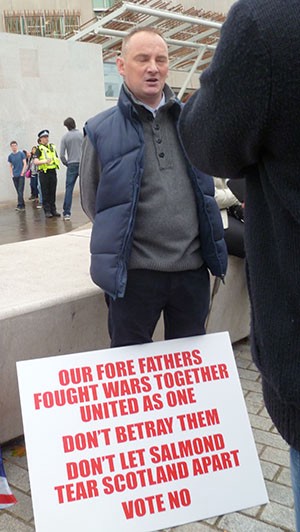
It was only later I met the NOs; they were not as easy to find. A man who called himself Saint George slowly played land of hope and glory on a shrill bone whistle, while a woman stood close with sparkling union jack earrings. Near them, a child sat close to the edge of the bench with a “No Thank You” balloon. “I’m YES and NO,” he told me. “And I’m FIVE.”

Later I went over the Salisbury Crags, and up to Arthur’s Seat, an extinct volcano in the heart of Edinburgh, which was once compared to a “couchant lion of massive size” by Walter Scott. In summer it is filled with people and an infinite sense of being young. Below the rocky top, people write their lover’s names in pebbles, which can be seen from above. People also gather here on bonfire night and the New Year, climbing the slope even when, as it was one year, seventeen degrees below zero and the ground is frozen solid.
The haar was thicker than it was the night before. Though from the parliament I was able see a saltire on the rocks — which the police viewed with interest — from the crags and Arthur’s Seat, I could hardly see anything, the mist thickening as I got higher. I strained to look down at the city and the people and flyers below. I thought something would be going on, but it was vacant, apart from two hill runners and a burst YES balloon lying deflated near the peak. I took a picture of it. Feeling that this made me responsible for it and any rabbit that might decide to eat it, I picked it up and put it in my bag, then slowly felt my way back down to the city.
When I got home I wrapped myself tightly in my duvet and shivered, suddenly cold after the long day.

I arrived at my friend’s results party at half past one in the morning. They thought I was the pizza delivery guy. “It’s pizza — crap, do you have a quid? I’m a quid short. PIZZA!” someone shouted from behind the door. A guy I hadn’t met before flung open the door. I explained that I didn’t bring pizza, but there were some Maltesers in my bag if anyone wanted them.
We watched as council after council declared “no,” and wondered if it was for the best. Even the celebrations of the fervent NOs at the party seemed somewhat muted. The Green Mantle pub, which had been granted a 5 a.m. license for the referendum, reportedly closed early — the landlord, a YES supporter, apparently sent everybody home. Outside the window, the city was weirdly silent, even though my friend’s apartment sits on one of the main thoroughfares.
We drank wine while we waited, and at 3:51 in the morning, the results from the city of Dundee came in: Yes. The NOs at the party put on comically exaggerated frowns to hide their fear as, for a moment, it looked like things might change. Then council after council called, quickly, one after the other: No, No, No. Gutted politicians were interrupted by newsreaders every minute, it seemed, for an incoming result. A guy showed me a video of cell division he made as part of his research into pig viruses; apparently there was some comparison between this and the incoming results. I couldn’t follow. Some YES people left. I logged onto Twitter and Facebook and saw hearts breaking all over the internet.
In the early morning, the politicians made their statements, but no one really listened or cared any more. I had already fallen asleep and missed hearing Edinburgh called. Apparently some people drank prosecco and said, “Cheers to whatever,” before the TV was switched off. Eleven hours after the results, Alex Salmond, the outspoken first minister who led the campaign for independence, would announce his resignation.
When I walked home, I saw the clean-up operation to pull the YES posters from the trees, the windows, and the lamp posts hadn’t started yet. It will soon. Ian, who hosted the party, sent us all a message this morning. “Thanks for coming folks, see you in twenty years.”
Hope Whitmore is a young writer who currently wanders between London, Edinburgh and Carcassonne, staying with family and friends, while seeking out interesting things to write about and people to interview.
How to Be an Ex-President
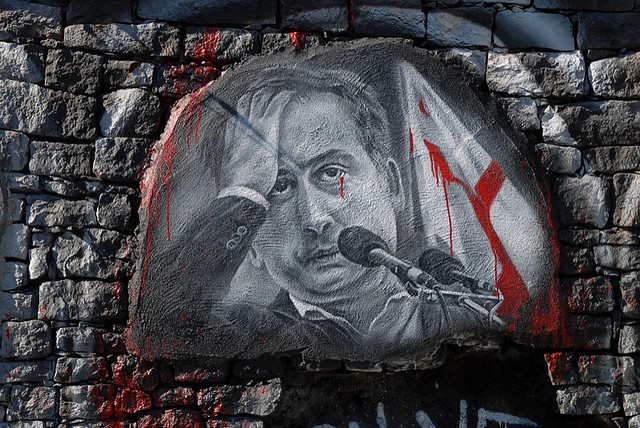
September, 2014:
At the Smorgasburg food fair in Williamsburg, Brooklyn, Mikheil Saakashvili motored in fluorescent green sneakers among bearded men with tattoos and women in revealing overalls. They lined up for Cheese Pops, Dun-Well Doughnuts and other local delicacies. He ordered a coconut. … Mr. Saakashvili is in self-imposed exile on North Seventh Street — plotting a triumphant return, even as his steep fall from grace serves as a cautionary tale to the many American government officials who had hoped he would be a model exporter of democracy to former Soviet republics.
Since leaving office last November, this George W. Bush favorite — whose confrontation with President Vladimir V. Putin of Russia led to a disastrous war in 2008 — has commandeered his uncle’s apartment in a tower on the Williamsburg waterfront, where he luxuriates in the neighborhood’s time-honored tradition of mysteriously sourced wealth. When not lingering in cafes, riding his bike across the bridge or spending stag evenings with friends on the Wythe Hotel rooftop, Mr. Saakashvili seizes on the Ukrainian conflict and his experience with Mr. Putin’s wrath as a lifeline back to political relevance.

April, 2009:
Unfortunately for Mr. Saakashvili, the opposition recently happened upon a virtual gold mine of material for their campaign on the racy personal blog of a female American massage therapist, who flew to Georgia to treat him in February.
The masseuse is named Dorothy Stein, but she goes by the nickname one of her many famous clients, Frank Zappa, gave her years ago: Dr. Dot. As she explained in a VH1 profile some years ago, her massage career began at the age of 14 when she offered to give members of the rock band Def Leppard back rubs as a way of getting to hang around with her idols backstage. With that early start, she set about compiling the impressive list of “satisfied customers” on her professional Web site, which now includes hundreds of famous rock stars and celebrities — like the Rolling Stones, Sting, Mariah Carey, Russel Crowe, Jay-Z, Juliette Lewis (who could play her in a biopic), Lauryn Hill, Ice-T, Eros Ramazotti and Bruce Willis, for starters.
It is not clear exactly when Dr. Dot added her most unusual massage technique — biting her clients backs — to her arsenal, but that certainly attracted the attention of Russia Today, the state-supported satellite channel that deals with Mr. Saakashvili roughly the way Fox News dealt with President Bill Clinton in the late 1990s

November, 2008:
Thousands of antigovernment demonstrators poured into the streets of Georgia’s capital, Tbilisi, on Friday, hoping to weaken the government of President Mikheil Saakashvili as it strives to maintain power despite a catastrophic war with Russia and a growing economic malaise at home.
The large, though generally subdued, demonstration occurred one year after black-helmeted riot police officers violently quashed opposition protests in Tbilisi, pelting unarmed civilians with clubs and rubber bullets, and using tear gas and water cannons to chase the protesters from the streets.
That event roused accusations domestically and internationally that the president’s promises of democracy and reform, which he made upon taking power in a bloodless coup in 2003, had fallen short, leaving Georgia only slightly more democratic than the country’s post-Soviet neighbors, including Azerbaijan, Armenia and Russia.

November, 2007
Mr. Saakashvili’s surprise announcement marked an effort to alleviate the domestic unrest and international concern after the police action in Tbilisi, the country’s capital, and the suspension of civil liberties. The president also said that the state of emergency would end soon, although he did say when.
More than 500 people were injured in the crackdown and clashes, none of them fatally, the government said. In the aftermath, public assembly was banned by Mr. Saakashvili’s emergency order and two opposition television stations were forced off the air.
One of the stations, Imedi-TV, carried the country’s most popular news programs; it was occupied by special forces officers. The government accused it of inciting unrest after it broadcast a statement from one of its owners, Badri Patarkatsishvili, calling for the end of Mr. Saakashvili’s government.

February 2004:
SOON after taking power in a pro-Western uprising in Georgia, President Mikheil Saakashvili journeyed in February 2004 to Moscow, his country’s former taskmaster, for his first talks with Vladimir V. Putin.
Here would be the climactic face-off: on one side, a young and impulsive modernizer who fancied himself leader of so-called color revolutions that would sweep away unsavory holdover regimes from the Soviet years. On the other, a dour and calculating ex-K.G.B. spy who saw much to like in the old ways and wanted to restore his nation to its proper glory.
Only one problem. Mr. Saakashvili at first didn’t show up.
He supposedly lost track of time while doing laps in his hotel pool, arriving at the Kremlin half an hour late and leaving Mr. Putin seething, according to three Georgians who were there.

January 2004:
When I became president of Georgia, they brought me money, and I said, “What is this?” They said, “It is your monthly wage.” It was roughly $40. I said: “Well, excuse me, I cannot survive on that. Give me some salary.” … It is up to $6,000 a month, plus all expenses. We’re still a poor country.
Photo by thierry ehrmann
Market Assessed Honestly
“The channel’s new name is intended to suggest something that pops, or stands out from the rest. ‘It’s something that rises above the noise … a one-of-a-kind maverick,’ Schwartz told The Times. ‘We’re going for a new audience that we are calling ‘the modern grown-up’ … people in their mid-to-late 30s that have pushed off emotional maturity.’” TV Guide, the channel that was always there, will become Pop, a channel that is still there.
New York City, September 17, 2014

★★★★★ The sun was a grand, universal spotlight, raising a glow from the fair hair of a child in a stroller, the white hair of a woman nearby, the creamy top of a panama hat crossing the street. Cornices cast grave and solid shadows. A fried egg tilted atop a sandwich or burger on a sidewalk table. The shift-changing taxis scattered an orange-yellow glow over the gas station lot. A rat worked its way along the dry and only slightly littered rail bed of the uptown B/D, ignoring the soggy garbage lake on the downtown side. Had it rained recently? Was it even possible, rain? Topside, at rush hour, the air swelled the ribcage and straightened the spine. It felt clean, even when flooded with waves of a misguided pedestrian’s cologne.
Camden in the Outfield
by Andrew Thompson
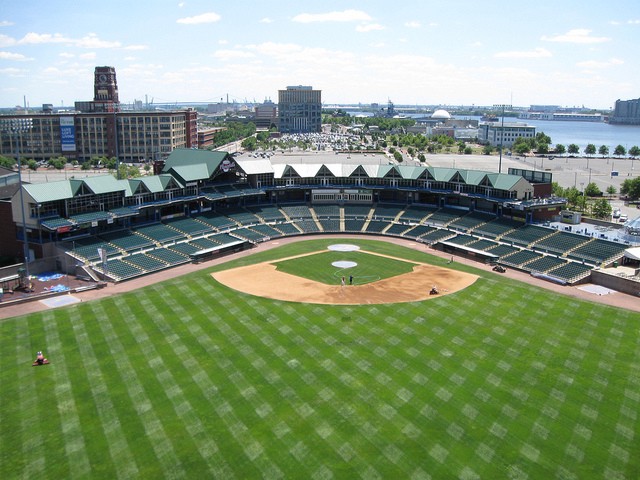
The other Sunday was Wedding Day at Campbell’s Field, the ballpark for the Camden Riversharks. Fans could have their vows renewed by the team’s general manager, a recently ordained minister, right on the field. About a half hour before the opening pitch, a middle-aged couple stood at home plate while he read their vows into a microphone. “I promise to love, honor and cherish you,” boomed the park’s speakers. It echoed back from the enormous medieval-looking stones supporting the Ben Franklin Bridge, along with the sandy, metallic gliding of a PATCO train riding along the bridge’s shoulder. When the manager instructed the groom, “you may kiss the bride,” the crowd went wild. When Lil Jon’s “Turn Down for What” replaced the wedding vows, the Riversharks took the field, prompting a light patter of applause, and the game began. They scored three runs, ultimately losing to the Lancaster Barnstormers by two points.
Campbell’s Field was built on the Camden waterfront in 1998 to fill the vast tract of empty space left behind by the Campbell’s Soup Company and RCA when they vacated the area in the sixties and seventies. By then, Camden had become one of the most vivid poster children for the casualties of post-industrialism; the only development on the waterfront was Riverfront State Prison. The New Jersey state legislature, looking to rehabilitate Camden and its image, hoped to repeat the success of Baltimore’s Inner Harbor and released millions of dollars in development funds to build an aquarium, a museum inside the refurbished hulk of a battleship, a large music venue where Phish played their third-to-last pre-breakup show, and a minor league baseball stadium.
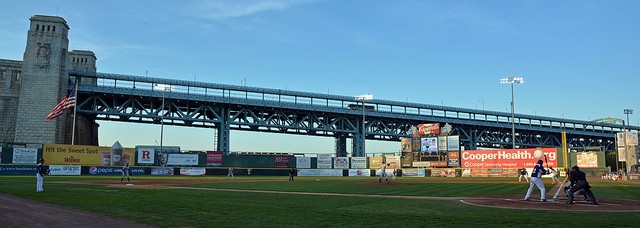
As the Riversharks were being defeated by the Barnstormers, just across the Delaware river, the Philadelphia Eagles were in the process of staging a spectacular comeback against the Jacksonville Jaguars. The stat keepers and Stewart spent much of their time distracting themselves from the baseball game by talking about the football game. “The Jaguars are up fourteen-nothing,” one of the stat keepers said early on, looking at his phone. Near the Kids’ Birthday Zone and concession counter, a sports bar full of drinkers were also watching the Eagles game. At the third inning, while purchasing boat of chicken tenders, I recognized the cacophony of an entire stadium squeezed into a tiny speaker, like a thousand bugs mouth-breathing at once, from the steel counter behind the cashier. I asked what game was playing on his radio. “The Eagles,” he said. By the fifth inning, Stewart had fallen asleep, his body a bean bag sagging over the edge of his chair, his wrist and shoulder mildly twitching.

The stadium feels like it’s in Philadelphia. Looking out from the press box, the point of focus is the Ben Franklin Bridge, which arches upward to the west and over the Delaware River to Philly, while the park’s merry-go-round, elevated on the concourse above left field, where it overlooks the river, might be the best viewing booth of the Philly skyline in the entire region. It’s only if you completely turn around from the merry-go-round’s vantage point that you see, peeking from behind the wall in back of right field, the brown towers of the Northgate housing projects — the only reminder from inside Campbell’s Field that you’re in Camden, New Jersey. The grounds outside the towers are one of the city’s more bustling open air drug markets, where dealers shout offers to sell PCP, which an East Camden woman used in 2012 when she decapitated her two-year-old son and put his head in his freezer before stabbing herself, and which a man days later used before entering a house and stabbing a six-year-old boy. That year, Camden, which has a population of just over seventy-seven thousand people, saw sixty-seven murders, a record, and an unemployment rate that peaked at 19.5 percent.
Each attraction is buffered from the others by a desert of parking lots, while the waterfront is separated from the rest of Camden by unoccupied luxury condos, which seem as if they were prefabbed with a sense of abandonment. The developments are also separated from Camden in another, crucial way: They don’t pay property taxes but instead have voluntary payment agreements with the city, making Camden’s portion of the Delaware River a Disney-like Hong Kong. And while jobs have been created, they have not gone exclusively to residents of Camden, where the unemployment rate currently stands at just under thirteen percent; the cashier listening to the Eagles at the concession stand told me he lived in Philly.
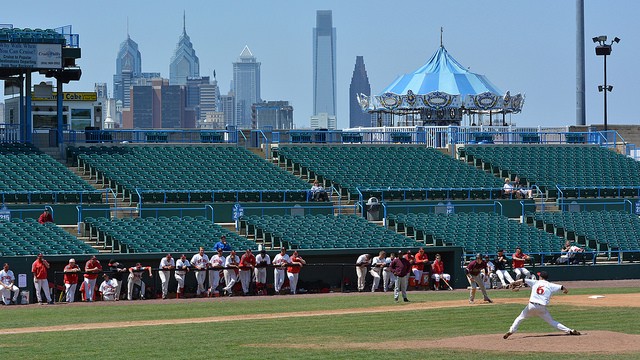
Stewart woke up when a park employee’s radio crackled with directions. “It’s time for the ice cream,” it said with the command of an air traffic controller. I couldn’t make out the pitcher’s number on the mound and asked one of the stat keepers who he was. “Ni,” he said. “Taiwanese guy.” I looked him up in one of the rosters stacked in the press room: Fu-Te Ni, thirty-one years old, started his career in the Chinese Professional Baseball League, where he pitched for the country’s fifth-place Olympic team. He was traded from the Barnstormers after spending two years in the Detroit Tigers’ AAA affiliate team. As of September 7th, he was two for five and had a 4.91 ERA. I looked over to Stewart; he had fallen back asleep.
Down in the lower deck, a little girl in pink shorts and a balloon hat was screaming at the Riversharks. “Come on Riverhsharks, why did we come here?!” She threw back a handful of Nerds, chewed, and then resumed her yelling. Another heckler, a man in his forties with greasy hair, 7–11 sunglasses, and Eagles Westbrook jersey, chided the umpire, “Hey Blue, you got a penny? Because you got nothing else going on.” He talked about the Eagles with the spectators to his left, then resumed heckling. “Hey, love your consistency or lack thereof, Blue.” He turned to the man sitting next to him. “It was nice meeting you,” he said. Then he got up and left.
Was the game over? Except for one crowd crescendo as a ball floated into a home run over left field, there was nothing indicating joy or disappointment of the progress of the game, just a low-grade swarm of unfocused activity. Children yelped, while the speakers announced that the loudest screamer would get a free slice of pizza. White noise emanated from the concourse’s food stands and sports bar and the grind of PATCO train. Yes, it was. The crowd funneled itself out of the field and through the entrance past where a Power Ranger once stood. Visitors took pictures outside the stadium, and spouses asked spouses where they had parked the car. In about an hour, with no other noise to drown it out, the whine of the PATCO train would be heard far more crisply.
Andrew Thompson is a writer living in Philadelphia.
Photos by The West End, cavalier92, Peter Miller, Paul Hadsall, and Peter Miller, respectively
The Content at the End of the World
Photographer QT Luong on shooting the Yosemite fires, which are still burning:
I heard of the fire on Twitter and saw a few dramatic photos on Monday morning. Some very extensive forest fires had been burning at the periphery of the park over the past couple years, but this time it happened in scenic the heart of the park, next to Yosemite’s icon, Half-Dome. After picking up my kids from school on Monday, I drove to Yosemite…
Watching the destruction of some of the forests where I had backpacked brought some sadness, although I knew that nature would eventually recover. Although I missed the most spectacular night, I was still fortunate to witness this awesome sight on two nights and the day in between, and I am glad that the fire is under control.
The very last media the world produces, as it burns or sinks or drifts or drifts out of orbit, will be some of its best. A silver lining!
Flying Lotus, "Coronus, The Terminator"
Another unusually approachable track, after the excellent “Never Catch Me” with Kendrick Lamar, from an artist who has otherwise never really worried about alienating people. The vocals, unattributed for now, are at the forefront; Ellison’s distinctive production reveals itself slowly and carefully.
